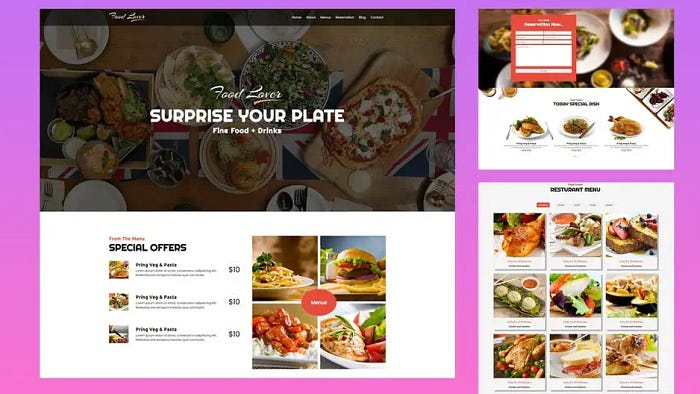Restaurant Website Using HTML CSS and JS
 OnlineITtuts
OnlineITtuts
Hey everybody, I hope you are all fine, today we are going to create a restaurant website using HTML CSS, and JS. Guys I’ve been creating projects using HTML CSS and JavaScript, So, I designed a completely responsive Restaurant Website using HTML and CSS, I would like to share with you how you can create it from scratch.
In today’s digital age, a well-designed website is crucial for any business, including restaurants. A visually appealing and user-friendly website not only attracts potential customers but also enhances the overall dining experience. In this article, we’ll explore the process of creating a restaurant website using HTML, CSS, and JavaScript.
I know there are many newbies or beginners facing problems with creating projects with any language. So, I’ve been sharing the projects that I built. However, let’s talk about the restaurant website inside the website you will learn how to use HTML and CSS to design it from scratch.
Also, you will learn how to use JavaScript to add functionalities such as displaying the dynamic category menus inside the website. And Also you will learn how to use a third-party library to add the sliders and manage it using CSS.
Restaurant Website Using HTML CSS and JS
Here is a complete video tutorial all about Restaurant websites using HTML CSS and JS you can watch. Inside the tutorial, you will learn everything from scratch practically.
I hope you’ve watched the complete tutorial, hope you’ve learned something new and you’ve got a lot of ideas from this tutorial. After watching the complete you can create another type of website using HTML CSS and JavaScript.
You May Also Like:
Planning and Structure:
Before diving into coding, it’s essential to plan the structure of your restaurant website. Consider the sections you want to include: home, menu, about us, contact, and perhaps a gallery. Sketching a rough layout will help you visualize the website’s design and functionality.
HTML for Structure:
HTML (HyperText Markup Language) forms the backbone of any web page. Start by creating the basic structure of your restaurant website using HTML. Divide your content into sections using appropriate tags like <header>, <nav>, <section>, <article>, and <footer>. This helps in organizing the content and makes your code more readable.
CSS for Styling:
CSS (Cascading Style Sheets) is crucial for styling and enhancing the visual appeal of your website. Use CSS to define the layout, colors, fonts, and overall aesthetics. Consider implementing responsive design techniques to ensure your website looks good on various devices, from desktops to smartphones. Leverage CSS frameworks like Bootstrap if you want to streamline the styling process.
Images and Media:
Enhance your restaurant website with high-quality images of your dishes, the interior, and the staff. Use the <img> tag in HTML to embed images and optimize them for the web to ensure faster loading times. Additionally, consider incorporating multimedia elements like videos or slideshows to showcase your restaurant’s ambiance.
Interactive Elements with JavaScript:
JavaScript adds interactivity to your website, making it more engaging for users. You can use JavaScript to create dynamic elements such as image sliders, interactive menus, or even reservation forms. Ensure that the use of JavaScript enhances the user experience without compromising on page load times.
Menu and Specials:
Devote a section of your website to display your menu and any special dishes or promotions. Use a combination of HTML and CSS to create an appealing layout, and consider adding JavaScript functionality for features like filtering by cuisine type or allergen information.
About Us and Contact Information:
Provide information about your restaurant, including its history, chefs, and the story behind your cuisine. Include contact details such as the address, phone number, and an interactive map for easy navigation. This section helps build a connection with potential customers.
Responsive Design:
With the increasing use of mobile devices, it’s crucial to ensure your restaurant website is responsive. Implement media queries in your CSS to adjust the layout based on the screen size, providing an optimal viewing experience for users on all devices.
Testing and Optimization:
Before launching your website, thoroughly test it across different browsers and devices to ensure compatibility. Optimize your code, images, and other assets to improve loading times. Consider implementing SEO best practices to enhance your website’s visibility on search engines.
How to Upload HTML Website on Server
If you’ve domain and hosting, then you can upload your website on the server. Once you do that, then your site will appear around the world, and you can access it anywhere you want. So, I made a tutorial on how to upload the website on the server so you can watch it.
Conclusion:
Creating a restaurant website using HTML, CSS, and JavaScript is an exciting project that allows you to showcase your culinary offerings in a visually appealing and accessible manner. By focusing on a well-structured layout, captivating design, and interactive elements, you can create a digital space that not only attracts customers but also enhances their overall dining experience.
Subscribe to my newsletter
Read articles from OnlineITtuts directly inside your inbox. Subscribe to the newsletter, and don't miss out.
Written by

OnlineITtuts
OnlineITtuts
As a dedicated front-end developer, I am passionate about crafting immersive and user-friendly digital experiences. With a keen eye for design and proficiency in HTML, CSS, and JavaScript, I specialize in translating creative concepts into responsive and visually appealing websites. My commitment to staying abreast of industry trends and technologies allows me to create dynamic and engaging user interfaces. Whether optimizing for mobile responsiveness or ensuring cross-browser compatibility, I bring a meticulous approach to every project. With a strong foundation in front-end frameworks like React and Angular, I thrive on transforming ideas into seamless, interactive, and aesthetically pleasing web applications that leave a lasting impression on users."